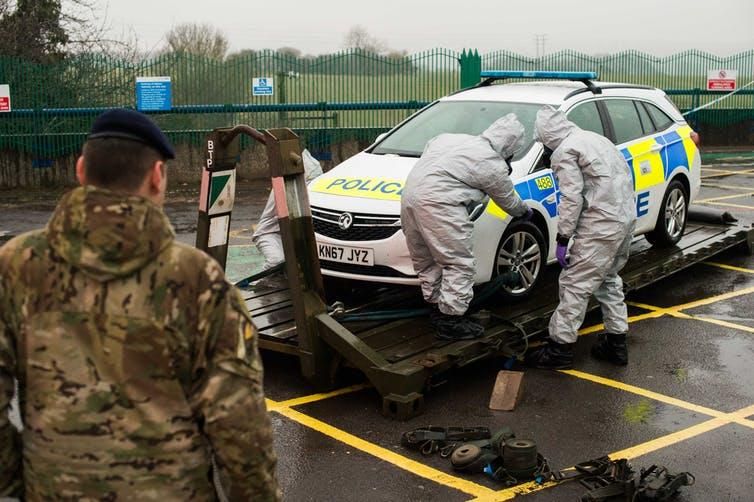How to Calculate the Danger of a Toxic Chemical to the Public
The risk of any toxin depends on the dose, how it spreads, and how it enters the body
/https://tf-cmsv2-smithsonianmag-media.s3.amazonaws.com/filer/f2/d4/f2d463bd-c08b-46ce-9e2a-d415c3d570ad/file-20180314-113475-1adc7v5.jpg)
The recent attempted poisoning of the former Russian spy Sergei Skripal and his daughter has led to warnings about the spread of the toxic chemical used in the attack. Hundreds of people who visited the restaurant where the attack is thought to have taken place have been told to wash their clothes to avoid any chance of contamination with the suspected “Novichok” nerve agent.
The danger to the public is thankfully thought to be minimal, with only a small risk coming from prolonged, repeated exposure to the tiny amounts of the chemical. But how do experts know what the danger really is in a situation like this? In order to assess the situation, they need to consider how much of the chemical was released, how it came into contact with people, and how it spreads and degrades in the environment.
We can be exposed to chemicals through our skin, by breathing them in, eating them, or injecting them into our blood. And the exact route can make a huge difference, just as breathing in oxygen keeps us alive but injecting it can kill us.
The most toxic compounds are lethal even in tiny doses. For example, the botulinum toxins, the most toxic substances ever discovered, can kill with just a few nanograms per kilogram of bodyweight if injected into veins or muscles. If inhaled, the lethal dose is in the tens of nanograms per kilogram of bodyweight.
Many of the best-known lethal substances, such as cyanide or arsenic, must be ingested to take effect. But other deadly compounds can be absorbed simply by touching them. This was what happened in the case of Katrin Wetterhahn, a professor in analytical chemistry who accidentally dropped a small amount of dimethylmercury onto her latex gloved hand. As this compounds easily diffused through latex, it was taken up by her body through the skin. She died of mercury poisoning five months later.
Sergei Skripal was poisoned with one of a class of nerve agents known as Novichok agents and chemically described as organophosphorus compounds. They act as an acetylcholinesterase inhibitor, which means that they disrupt the central nervous system. These compounds can come in solid, liquid or gas form, and we know nerve agents work when ingested or inhaled. But it’s not yet clear what specific chemical compound was used in this case and how it was administered. Because of this, we don’t know how much of the agent was needed or how the victims were exposed.

How dangerous a chemical can be also depends on how easily it can spread and contaminate the environment. The physicochemistry of a substance plays an important role here. Arsenic has a melting point of over 600℃ so if it were sprinkled into food it would be unlikely to travel far from the plate because it is solid at room temperature.
But lethal compounds dispersed as gases, like the alleged use of chlorine gas in the Syrian civil war, can result in the instant spread of the chemical across a wide area. This means they can affect many more people, although as they become more widely dispersed they become less harmful to individuals because the doses people receive are lower. Similarly, poisons in liquid or aerosol form, or radioactive solutions can be easily transferred from one surface to another.
Once they’ve entered the environment, chemicals often begin to change or break down, rendering them less harmful over time. For example, when chlorine gas comes into contact with an oxidisable material, such as wood or clothing, it changes into a harmless, inert chloride compound.
**********
In the case of radioactive material, how long the substance is dangerous depends on how quickly its atoms lose energy, a process known as radioactive decay and measured by what’s called a half-life. When another former Russian spy, Alexander Litvinenko, was assassinated in the UK in 2006, the murder weapon was radioactive polonium-210 put into his cup of tea. Polonium-210 has a half life of 139 days, meaning after this time half of its atoms have emitted an alpha particle and decayed into polonium-206 atoms.
This alpha radiation emitted inside his body after he had drunk the poisoned tea was what made Litvinenko ill and eventually killed him a month later. But those who came into close contact with him, such as his nurses, would have been much less exposed to the radiation. Alpha particles do not travel a long way and are stopped by even minor obstacles such as a piece of paper or human skin.
Organophosphorus nerve agents including Novichok and sarin, which was used in the Tokyo subway attack that resulted in 13 deaths, are unstable and break down gradually over time or when exposed to water. This is why washing your clothes after being exposed to such a compound could be enough to get rid of it. In fact, organophosphorus-based nerve agents are so unstable that they are often stored as two or more separate compounds and then combined when needed.
The ability to react easily with other substances is what makes lethal chemicals so dangerous, to both their intended victims and innocent bystanders. As a result, these aggressive substances do not typically linger for long. But if they encounter something that holds them on its surface until it releases them again, this can extend their potentially damaging lifetime. Metallic door handles are a good example for the transfer of material from one person to another.
For those cleaning up a contaminated site, all these factors are vital to understanding what they are facing and how they can prevent anyone else falling victim to a deadly chemical.
This article was originally published on The Conversation.
Vera Thoss, Lecturer in Sustainable Chemistry, Bangor University